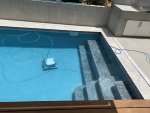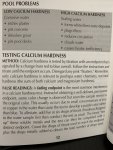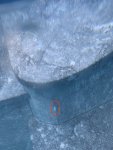We completed construction of our pool last summer, this weekend we swam for the first time this year. I noticed some calcium noodles around the marble steps, one large one I crushed with my fingers - it was very white rock like, some larger pieces, but also lots of fine dust that I could not collect as it just dispersed in the water.
I tried taking some pictures of a couple of smaller ones, these as well as the larger that I crushed all appeared in grouting between pieces of natural marble (Aliveri Grey Marble), or between the marble and the plastered (beadcrete) surface.


An overview of the steps and the rest of the pool

I came across Calcium Nodules in pools and it looks plausible it is the same, but a cavity on the back side of the marble pieces, with the marble dissolving slowly.
In this case, would the recommended solution be to find and fill the tiny holes with epoxy ?
How about dissolving marble from the steps them self ? Is that something I should be concerned about ?
I have a Taylor 2006 test kit, these are the most recent measurements.
FC 16
CC 0.5
PH 7.3
TA 90
CH 500 (but not sure I can trust this, see below ...)
CYA 50
Salt 3200
TEMP 27 degrees C or 81 degrees F
CSI -0.22
I had some cloudy water about a week ago, so I did a SLAM that is the reason for the high FC.
I've always found it difficult to get a reliable Calcium Hardness reading, it doesn't chance colour clearly, but I get a purple colour, and I find it difficult to know when to stop counting, I tried adding a few drops of the hardness reactant as suggested in the manual, but I still see a fading end point.

Any ideas here ?
I tried taking some pictures of a couple of smaller ones, these as well as the larger that I crushed all appeared in grouting between pieces of natural marble (Aliveri Grey Marble), or between the marble and the plastered (beadcrete) surface.


An overview of the steps and the rest of the pool

I came across Calcium Nodules in pools and it looks plausible it is the same, but a cavity on the back side of the marble pieces, with the marble dissolving slowly.
In this case, would the recommended solution be to find and fill the tiny holes with epoxy ?
How about dissolving marble from the steps them self ? Is that something I should be concerned about ?
I have a Taylor 2006 test kit, these are the most recent measurements.
FC 16
CC 0.5
PH 7.3
TA 90
CH 500 (but not sure I can trust this, see below ...)
CYA 50
Salt 3200
TEMP 27 degrees C or 81 degrees F
CSI -0.22
I had some cloudy water about a week ago, so I did a SLAM that is the reason for the high FC.
I've always found it difficult to get a reliable Calcium Hardness reading, it doesn't chance colour clearly, but I get a purple colour, and I find it difficult to know when to stop counting, I tried adding a few drops of the hardness reactant as suggested in the manual, but I still see a fading end point.

Any ideas here ?
Attachments
Last edited:


